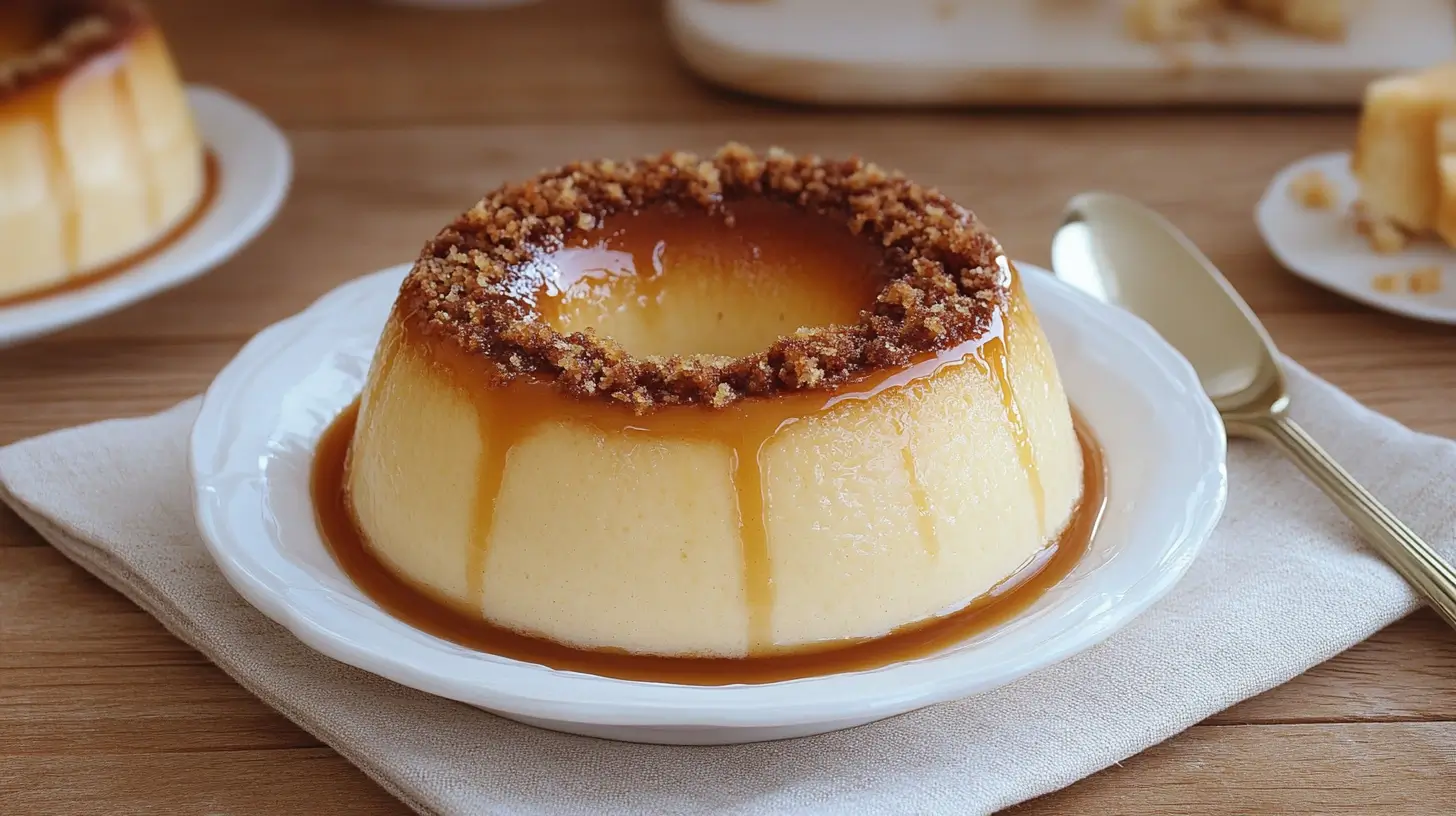Milk pudding, a timeless dessert loved by many, is a versatile treat that’s easy to prepare and impossible to resist. Whether you enjoy it plain, flavored with exotic ingredients like rose water, or topped with coconut shreds, milk pudding is a dish that promises comfort in every bite. This article explores everything you need to know about milk pudding: its origins, popular recipes, health benefits, and serving tips. Dive in to discover why this simple yet indulgent dessert deserves a spot on your table.
What is Milk Pudding?
Milk pudding is a soft, creamy dessert crafted from simple ingredients like milk, sugar, and a thickening agent, such as cornstarch. This melt-in-your-mouth treat has a smooth texture that pairs beautifully with toppings like fresh fruit, nuts, or shredded coconut. The beauty of milk pudding lies in its simplicity—it’s a dessert that’s as easy to make as it is delightful to eat.

A Brief History of Milk Pudding
The history of milk pudding spans centuries and cultures. Its roots trace back to medieval Europe, where variations like blancmange were served as delicacies in royal courts. Over time, this dessert spread across the globe, inspiring regional adaptations like Middle Eastern mahalabiya and Asian milk custards. Each version incorporates local flavors while staying true to the comforting essence of milk pudding.
Cultural Significance of Milk Pudding Worldwide
Milk pudding holds a special place in various culinary traditions. In the Middle East, it’s often infused with cardamom and rose water for festive occasions. In Asia, it features prominently in street food stalls and home kitchens, sometimes served with unique toppings like matcha or mango. Meanwhile, European versions emphasize the creamy consistency and are often paired with rich sauces or fruit compotes. No matter the region, creamy dessert is cherished for its ability to bring people together over a shared love of desserts.
Ingredients and Preparation Techniques
Essential Ingredients for Milk Pudding
Making creamy dessert requires just a handful of basic ingredients, making it a favorite for quick and satisfying desserts. The traditional recipe usually includes:
| Ingredient | Quantity | Purpose |
|---|---|---|
| Milk | 500 ml | Forms the creamy base of the pudding. |
| Sugar | 50 g | Adds sweetness to the dessert. |
| Cornstarch | 50 g | Acts as the thickening agent. |
| Vanilla Extract | 1 tsp | Enhances flavor (optional). |
| Caramel Sauce | 2-3 tbsp | For drizzling on top (optional). |
| Crushed Cookies | 2-3 tbsp | Adds crunch as a garnish (optional). |
Variations in Ingredients – Coconut Milk, Almond Milk, and More
The versatility of milk pudding lies in its adaptability. For lactose-intolerant individuals, coconut milk or almond milk are excellent alternatives that retain the creamy texture. Coconut milk adds a slightly tropical flavor, perfect for pairing with fruit toppings. Almond milk offers a nuttier taste, which complements additions like toasted almonds or caramel drizzle.
For a healthier twist, consider replacing sugar with natural sweeteners such as honey or maple syrup. Additionally, you can experiment with thickening agents like agar-agar for a vegan option.
Tips for Perfecting the Pudding Texture
Achieving the perfect texture is key to a successful creamy dessert. Here are some tips:
- Dissolve Cornstarch Properly: Always mix the cornstarch with a small amount of cold milk before adding it to the heated milk to avoid lumps.
- Low Heat is Key: Cook the mixture over low to medium heat, stirring constantly to prevent burning.
- Cool Gradually: Allow the pudding to cool at room temperature before refrigerating to avoid forming a skin on the surface.
- Experiment with Consistency: If you prefer a firmer pudding, slightly increase the amount of thickening agent.
By mastering these simple techniques, your milk pudding will turn out smooth, creamy, and irresistible every time.

Top Milk Pudding Recipes
Classic Milk Pudding Recipe Step-by-Step
A classic milk pudding recipe is an easy starting point for anyone looking to create this delightful dessert. Follow these steps:
- Combine 500ml of milk with 50g of sugar in a saucepan.
- In a separate bowl, dissolve 50g of cornstarch in 100ml of milk.
- Heat the milk and sugar mixture over medium heat until warm, but not boiling.
- Gradually add the cornstarch mixture while whisking continuously.
- Cook until the mixture thickens, then pour it into molds or a serving dish.
- Chill for 2-3 hours before serving.
Asian Variants: Taiwanese and Japanese Inspirations
In Taiwan, milk pudding often incorporates ingredients like condensed milk for extra richness and is served with toppings like boba or grass jelly. Japanese variants, on the other hand, lean towards minimalism, often using only milk, gelatin, and sugar for a silky, wobbly dessert known as purin.
Modern Twists: Infusions with Coffee, Matcha, or Rose Water
For a modern take on milk pudding, experiment with flavors:
- Coffee Milk Pudding: Add a teaspoon of instant coffee granules to the milk mixture for a rich and aromatic dessert.
- Matcha Milk Pudding: Whisk in matcha powder for a subtle, earthy flavor and vibrant green hue.
- Rose Water Pudding: Infuse the pudding with a few drops of rose water for a fragrant and elegant dessert, ideal for special occasions.
Nutritional Aspects and Health Benefits
Caloric Information and Macros of Milk Pudding
| Nutrient | Per 100g Serving | Details |
|---|---|---|
| Calories | 120-150 kcal | Varies based on the type of milk and sugar used. |
| Protein | 4-6 g | Comes mainly from the milk base. |
| Carbohydrates | 15-20 g | Includes sugars and starch for thickening. |
| Fats | 2-5 g | Depends on whether whole milk or low-fat milk is used. |
| Fiber | 0 g | Typically contains no fiber unless garnished with nuts or seeds. |
| Sugar | 12-15 g | Can be reduced by using low-sugar alternatives. |
| Calcium | 100-150 mg | High calcium content from milk for strong bones. |
Low-Sugar and Dairy-Free Options
For a healthier twist, replace sugar with natural sweeteners like honey or maple syrup. These choices lower the glycemic index and add subtle new flavors to the dessert.
Dairy-free alternatives like almond milk, oat milk, or coconut milk work wonderfully in creamy dessert Coconut milk adds a tropical flavor and creamy texture, while almond milk provides a hint of nuttiness. These swaps ensure everyone can enjoy creamy dessert, even those with dietary restrictions.
If you’re looking for more light dessert options, check out this Mini Banana Pudding Cups recipe for another easy, delightful treat.
Frequently Asked Questions (FAQs)
What is classed as milk pudding?
Milk pudding is any dessert where milk is the main ingredient, thickened with cornstarch, gelatin, or eggs. Its smooth texture and mild flavor make it a universal favorite.
What is another name for milk pudding?
Depending on where you are, soft pudding may go by different names. In France, it’s blancmange; in the Middle East, it’s known as mahalabiya. Each variation reflects local flavors and traditions.
What does milk pudding taste like?
Milk pudding tastes creamy and slightly sweet. Its mild flavor is versatile, serving as a base for toppings like fruit, syrups, or spices such as cinnamon or cardamom.
What’s the difference between custard and milk pudding?
While both are creamy desserts, custard relies on eggs for thickening, creating a richer texture. creamy dessert, on the other hand, uses starch or gelatin, resulting in a lighter consistency.
For more dessert inspiration, check out Strawberry Cheesecake Dump Cake, another simple and delightful option.
Creative Serving Ideas and Presentation
Toppings and Garnishes for Milk Pudding
Adding the right toppings can transform milk pudding from a simple dessert into something extraordinary. Fresh fruits like strawberries, blueberries, or diced mango add a burst of color and natural sweetness. For a crunch, try sprinkling crushed nuts such as pistachios or almonds on top. Syrups and sauces, like chocolate, caramel, or berry compote, create a luxurious finishing touch.
For something unique, consider garnishing the pudding with shredded coconut or edible flowers. These additions not only elevate the flavor but also enhance the visual appeal, making the dessert Instagram-worthy.
Serving Suggestions: Individual Portions vs. Family-Style
How you serve milk pudding can set the tone for any occasion. For a chic, modern presentation, use small jars, ramekins, or clear glass cups. This approach highlights the pudding’s creamy layers and any colorful toppings.
Alternatively, you can serve creamy dessert family-style by pouring it into a single dish and slicing it into portions once set. This method works wonderfully for casual gatherings, as everyone can serve themselves. To impress, add a decorative layer of fruit or a sprinkle of powdered sugar before presenting it on the table.
Milk Pudding Around the World
European Takes: Blancmange and Related Desserts
Europe has embraced milk pudding in various forms. The French version, blancmange, combines milk, sugar, and gelatin to create a silky dessert often flavored with almond. Italians enjoy panna cotta, a cream-based pudding similar to blancmange but slightly richer in taste. Both are typically served with fruit compotes or delicate syrups, making them ideal for festive occasions.
Middle Eastern Versions: Mahalabiya and Beyond
In the Middle East, milk pudding transforms into mahalabiya. This fragrant dish is infused with rose or orange blossom water, creating a floral aroma that pairs beautifully with toppings like crushed pistachios or dried fruits. Mahalabiya is a staple at celebrations, loved for its smooth texture and subtle sweetness.
Fusion Flavors: Blending Cultures in a Bowl
Modern chefs are blending cultures by reimagining milk pudding with global flavors. For instance, matcha-infused mahalabiya offers an exciting combination of Japanese and Middle Eastern influences. Similarly, adding saffron and cardamom to European blancmange creates a luxurious dessert with Indian flair.
Conclusion – Why Milk Pudding Deserves a Place on Your Table
Milk pudding is more than just a dessert—it’s a celebration of simplicity and versatility. Its smooth texture and subtle sweetness make it a universal favorite, while its adaptability allows for endless flavor combinations. Whether you stick to the classic recipe or experiment with bold infusions like matcha or saffron, creamy dessert is a blank canvas for culinary creativity.
This dessert’s global reach highlights its appeal, from the rosewater-infused mahalabiya of the Middle East to the almond-scented blancmange of Europe. Each variation carries a piece of the culture it represents, turning every spoonful into a sensory experience.
What truly sets creamy dessert apart is its ability to bring comfort and joy with minimal effort. It’s easy to prepare, requires basic ingredients, and can be dressed up or down to suit any occasion. Whether served as a family-style treat or as individual portions at an elegant dinner party, it never fails to impress.

